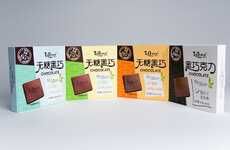
Cadbury's Scientists Come Up With Recipe for Non-Melting Chocolate
Jonathon Brown — December 4, 2012 — Lifestyle
Cadbury's scientists in Britain have solved the age old dilemma of trying to consume chocolate in hot temperatures by inventing non-melting chocolate. The key to this development isn't the creation of non-melting chocolate itself, but non-melting chocolate that tastes like regular chocolate.
In the 1930s, Hershey's developed and manufactured chocolate bars to be carried in a pocket or at high temperatures for soldiers. These bars were then used during World War II, but weren't attractive to the average consumer because of their "gritty" taste. These bars were created to supply soldiers the energy they needed to fight, not to act as comfort food or a sweet treat.
This non melting chocolate is said to taste very similar to regular chocolate and has been tested for three hours at 40º C.
In the 1930s, Hershey's developed and manufactured chocolate bars to be carried in a pocket or at high temperatures for soldiers. These bars were then used during World War II, but weren't attractive to the average consumer because of their "gritty" taste. These bars were created to supply soldiers the energy they needed to fight, not to act as comfort food or a sweet treat.
This non melting chocolate is said to taste very similar to regular chocolate and has been tested for three hours at 40º C.
Trend Themes
1. Temperature-tolerant Chocolate - Cadbury's non-melting chocolate offers disruptive innovation potential for the confectionery industry, allowing chocolate to be enjoyed in hot temperatures without melting.
2. Heat-resistant Food Products - The development of non-melting chocolate opens up opportunities for creating other heat-resistant food products, providing new options for consumers in hot climates or during warmer seasons.
3. Improving Taste and Texture - The challenge to make non-melting chocolate taste like regular chocolate presents an opportunity for food companies to enhance and refine the flavor and texture of heat-resistant sweet treats.
Industry Implications
1. Confectionery - The confectionery industry can leverage non-melting chocolate to expand into markets with hot climates or for outdoor events, where traditional chocolates would typically melt.
2. Food and Beverage - The food and beverage industry can explore the use of temperature-tolerant ingredients to create new products that can withstand hot temperatures without compromising taste or texture.
3. Military Food Supply - The development of non-melting chocolate can be applied to military food supply, offering soldiers a durable and enjoyable option for sustenance in high-temperature environments.
2.1
Score
Popularity
Activity
Freshness























